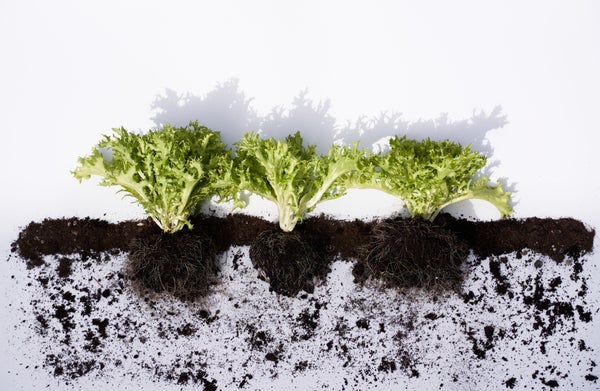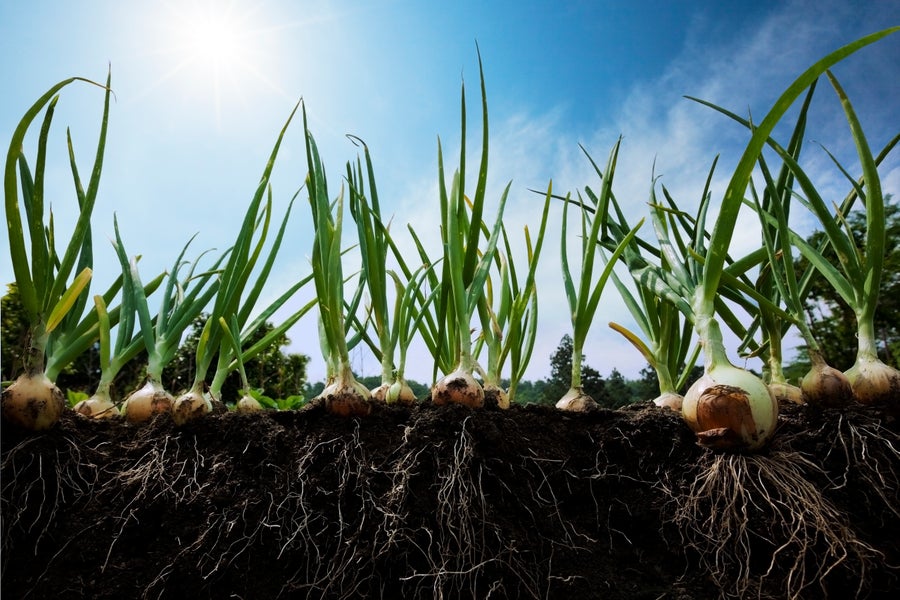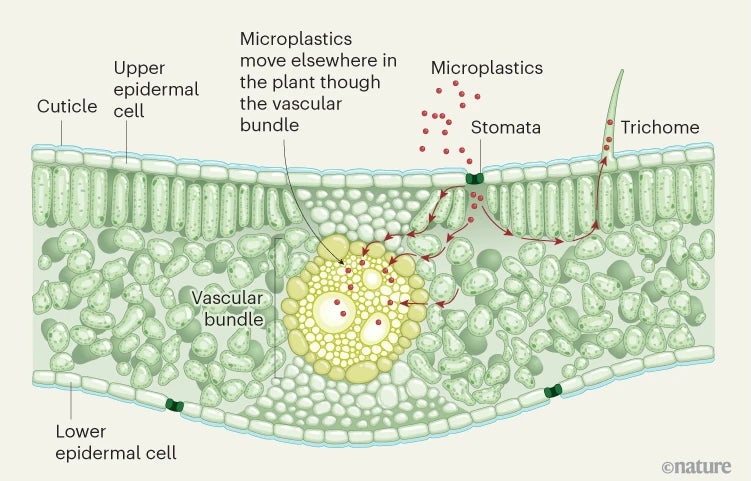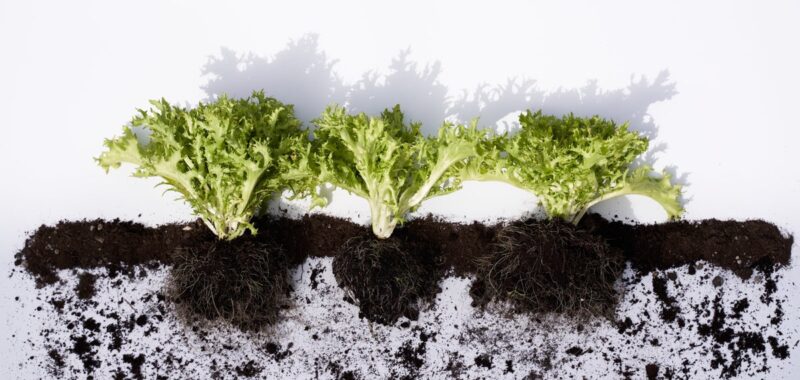Plant Leaves Absorb Microplastics—And They End Up in Our Food
New evidence shows plant leaves absorb airborne microplastics, a previously overlooked route for the particles to enter crops that has implications for ecology and human health

Plants can absorb plastic particles directly from the air.
Ruben Bonilla Gonzalo/Getty Images
Plastic production is increasing sharply. This has raised concerns about the effects of microplastics (typically defined as plastic particles smaller than 5 millimetres in diameter) and nanoplastics (smaller plastic particles that are less than 1,000 nanometres in diameter) on human health. These concerns are partly influenced by alarming findings of the presence of microplastics in various human tissues, including the brain and placenta. Continuing research is examining pathways of human exposure to microplastics, including through food sources. Most attention is focused on soil and water as common sources of plastics that enter the food chain. However, writing in Nature, Li et al. provide strong evidence supporting the air as being a major route for plastics to enter plants.
Plants can absorb plastic particles directly from the air. Particles in the air can enter leaves through various pathways, such as through structures on the leaf surface called the stomata and through the cuticle. Stomata are small openings made of cells, and the cuticle is a membrane, covered in insoluble wax, that is well suited for absorbing microplastics.
Once inside the leaf (Fig. 1), microplastics move through spaces between plant cells and can also accumulate inside tiny hair-like structures, called trichomes, on the surface of leaves. Microplastics can also travel to and enter the plant’s water- and nutrient-transporting system (called the vascular bundle) and from there reach other tissues. Trichomes are ‘sinks’ for external particles and they therefore reduce the efficiency of microplastic transport from leaves to roots. Given that leaves are a key part of the food chain, microplastic particles that accumulate here can easily pass to herbivores and crop leaves, both of which can be directly consumed by humans.
On supporting science journalism
If you’re enjoying this article, consider supporting our award-winning journalism by subscribing. By purchasing a subscription you are helping to ensure the future of impactful stories about the discoveries and ideas shaping our world today.

Microplastics can also travel to and enter the plant’s water- and nutrient-transporting system (called the vascular bundle). From there, microplastics can reach other tissues.
Li and colleagues’ study demonstrates that the absorption and accumulation of atmospheric microplastics by plant leaves occurs widely in the environment, with the concentrations of these particles in plants being consistent with their concentrations in air at the sampling sites. The authors report that the concentrations of the microplastics polyethylene terephthalate and polystyrene were 10–100 times higher in open-air planted vegetables than in greenhouse-grown vegetables. Leaves with a longer growth duration and the outer leaves of vegetables contained higher microplastic concentrations than did younger leaves and inner leaves. Microplastic concentration in plants increased with the duration of exposure to these particles.
Although the efficiency of leaf uptake of microplastics is extremely low (around 0.05%), Li and colleagues’ findings provide evidence from fieldwork of accumulation of atmospheric microplastics in leaves. The relative importance of this airborne exposure to microplastics in plants compared with that of other uptake routes is difficult to assess, because information available on microplastic uptake through soil and water is sparse. Li et al. report concentrations of polystyrene nanoplastics of about 7–10 nanograms per gram of the dry plant weight for lettuce leaves after outdoor exposure in Tianjin, China.
In the case of exposure to microplastics in the water, plastic concentrations similar to those found in plants by Li and colleagues after airborne deposition could only be obtained previously by exposing lettuce roots to polystyrene nanoplastics in water, at exposure levels as high as 5 milligrams of plastic per litre of water. Another study examining plant exposure to microplastics in water reported that there was no plant uptake of these plastics from water entering a wastewater treatment site. In soil cultivation experiments reported by Li and colleagues, the root absorption of polystyrene nanoparticles that ended up in the shoot was less efficient than the absorption of airborne nanoplastics. Li and colleagues found that the level of the plastics that reached leaves from roots were well below the 7–10 nanograms per gram of dry plant weight that is associated with airborne deposition of nanoplastics. Li et al. report that levels of microplastics in air-exposed plants at highly microplastic-contaminated sites increased mostly tenfold compared with levels at non-contaminated sites.

Researchers have found that microplastics in the air can enter plants, including crops, through the outer layer of cuticle and epidermal cells. They can then move through spaces between plant cells to enter tiny hair-like structures on the leaf surface called trichomes. Alternatively, after entering the leaf, microplastics can move to cells in a system called the vascular bundle that transports water and nutrients to tissues elsewhere in the plant.
These findings illustrate the potential implications of airborne microplastics and nanoplastics accumulating in leaves and being transferred to herbivores and humans. This highlights a possible yet understudied pathway of plastic exposure that might have ecological and health implications. However, key gaps remain in scientists’ understanding of the various factors that influence the uptake, accumulation and biological effects of microplastics in humans. These knowledge gaps include: the composition of the average human diet and its role in determining exposure levels; the efficiency with which plastics accumulate in the gut; and the extent to which these particles reach key organs. Furthermore, there is a major lack of data on the threshold levels at which microplastics and nanoplastics might begin to exert harmful effects on human health.
The combination of these uncertainties severely hinders efforts to accurately quantify the potential risks posed by airborne microplastics. Without a comprehensive and systematic approach to studying plastic fate and toxicity, our understanding remains incomplete. The current body of knowledge about the environmental and physiological effects of plastics is full of gaps, with no consistent data available on plastics of well-defined compositions, sizes, shapes or densities.
A conclusion to draw from Li and co-authors’ work is that, although there is no widely supported consensus on the risks to humans from exposure to plastics, the deposition of these substances from the air into human food is an exposure pathway not to ignore. Combining these concerns with considerations of direct exposure of humans to airborne plastics might suffice to prompt the adoption of precautionary measures. Although research on the long-term health effects of plastics is still continuing, preliminary research suggests possible links to problems with breathing, inflammation and other adverse health outcomes. Given these uncertainties, integrating precautionary approaches — such as reducing plastic use and increasing public awareness — might help to lessen potential risks. Proactive measures might also encourage further scientific investigation into the extent of microplastic exposure and its health implications, ensuring better protection for individuals and for the environment.
This article is reproduced with permission and was first published on April 9, 2025.

